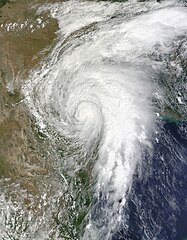iorange55 wrote:I do still expect that even if DFW proper doesn't get any snow this winter (because that is always a crapshoot), somebody within 100 miles or so will have accumulating snow that we can chase after.
Why did no one invite me to the funeral?

We'll have some chances this winter; I am sure of it! Well, maybe not
sure, but I am confident. I can't remember two winters in a row with no real winter storm rolling through. I'm sure there has been, but usually we get at least one snow/ice storm a year here in DFW.
It will not be like last winter...it can't be! RIGHT? RIGHT?

Actually, this time last fall we were wetter than we are now for October and November. (3.34" for Oct 2011 at Lavon Dam vs .86" this year and over 1" in my guage last yr for November vs. goose-egg this year). Also, statistically, if we wait long enough, it should rain again sometime in the future, although, it doesn't seem to take much these days to exceed 3 standard deviations of extremes like it used to. A Hydrology Engineering professor told me to throw all past empirical data out the window when it comes to designing storm water runoff systems for cities because future climate will not resemble anything that we have designed off of in the past.
Something as basic as having to wait weeks between rainfall is going to have an effect on everything we do...even as I sit in this comfy house with water that still comes out the tap, a functioning computer, electricity, and food I can still buy off store shelves. Look at it this way: 12.7% more people in this state since 2000 + Major drought in an already water-starved area of the country + climate change that is almost guaranteed to raise evaporation rates and expand subtropical dryness over our state permanently + poor water management in most areas = recipe for disaster. Look at these as examples
THE TEXAS FOREST SERVICE RECENTLY COMPLETED ITS EXTENSIVE STUDY OF
TREE MORTALITY. OVER 300 MILLION RURAL TREES ARE ESTIMATED TO HAVE
BEEN LOST DURING THE 2011 DROUGHT. AN ADDITIONAL 5.6 MILLION URBAN
TREES DIED STATEWIDE. ACROSS NORTH AND CENTRAL TEXAS...BETWEEN 8 AND
9 PERCENT OF THE TREE POPULATION DID NOT SURVIVE THE DROUGHT. EVEN
LIVING TREES HAVE BEEN SIGNIFICANTLY DESSICATED. FOR THE FORESTRY
INDUSTRY...IN WHICH TREES ARE SOLD BY WEIGHT...THIS MOISTURE LOSS
CAN REDUCE THE WEIGHT OF WOOD BY AS MUCH AS 50 PERCENT.
and:
SUMMARY OF IMPACTS...
AGRICULTURAL IMPACTS
DUE IN LARGE PART TO THE EXTRAORDINARY DROUGHT ACROSS MUCH OF THE
CENTRAL PART OF THE COUNTRY...CROP YIELDS NATIONWIDE WERE BELOW
DEMAND FOR THE FIRST TIME IN 38 YEARS. BUT IN TEXAS...SOME CROPS
(INCLUDING PECANS) HAD ABOVE NORMAL YIELDS. EVEN FOR CROPS THAT
STRUGGLED...THE CONDITION WAS FAR BETTER THAN IN 2011.
THE CROP CONDITION INDEX...WHICH IS BASED ON STATEWIDE RATINGS...IS
ON A SCALE FROM 5 TO 110. INVARIABLY...CURRENT CROP CONDITION INDEX
VALUES ARE FAR BEYOND THE DISMAL LEVELS AT THIS TIME ONE YEAR AGO.
THE HARVEST IS DONE FOR CORN AND COTTON...BUT IS STILL ONGOING FOR
SORGHUM AND SOYBEANS.
CURRENT CROP CONDITION INDEX VALUES
2012 2011
CORN 70 33
COTTON 46 34
SORGHUM 68 49
SOYBEANS 68 18
So I guess we were lucky in Texas in this aspect, relatively speaking. Anyway, I think we need to be realistic and realize Texas has a serious water problem looming that will take massive amounts of problem-solving to remedy, as well as changes in how we live. I raise cattle in South Texas and can only keep half as many head of cattle as I could in the 70's because of persistant drought. I have come to the realization that these changes are permanent, at least in our lifetimes.















 . I was speaking long term that those looking for a reversal from the dry outduelling wet will not come. Should lower expectations.
. I was speaking long term that those looking for a reversal from the dry outduelling wet will not come. Should lower expectations.


